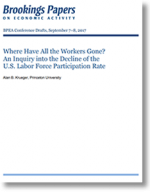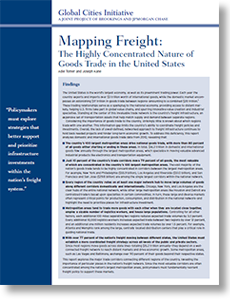Mapping Freight: The Highly Concentrated Nature of Goods Trade in the United States
This report explores the major trade corridors connecting different regions of the country, revealing the importance of particular places in the nation’s freight network.
Each year, the United States moves over $20 trillion in goods weighing over 17 billion tons between hundreds of metropolitan, non-metropolitan, and international regions.
It does so using an extensive network of freight assets: over 4 million miles of highways, local roads, railways, navigable waterways, and pipelines; hundreds of seaports and airports; and thousands of intermodal facilities to tie the network together.
Without this network, it would be impossible for regional economies to trade goods and reach their full economic potential.
Managing this network rests on the shoulders of both the public and private sectors, which share various responsibilities in planning and policy development.
The public sector owns and operates assets like airports and interstate highways, while also regulating local land use and national safety standards.
In contrast, the private sector operates vehicles and other equipment to move goods, while owning distribution centers and other freight assets such as rail lines.
Today, this public-private relationship is at a critical juncture. From the federal to the local level, freight policy has frequently fallen short with its private sector partners, moving forward without a central purpose or set of clearly defined economic priorities.
As a consequence, metropolitan economies - and the firms located within them - may increasingly be at a competitive disadvantage with their global peers.
Federally, the national strategy is outdated and overly stovepiped. National transportation policy focuses on connectivity, epitomized through the National Highway Trust Fund’s effort to build the interstate highway system and forge physical bonds across the country.
In many ways, that investment has proven a great success, but it treats every state and metropolitan area as relatively equal traders within the larger national system.8
To make matters worse, there is no dedicated freight investment program designed to support the country’s multimodal freight network. National trade policy also provides little clarity concerning freight, concentrating instead on international agreements and where goods enter or exit the country.
This approach ignores domestic trade between metropolitan areas and, in particular, the supply chains that connect metro areas to one another and to U.S. ports.
Freight strategies have also frequently been lacking at the state and local levels.
Although states physically built the national highway system by connecting major population centers to one another and to rural production hubs, many did not necessarily prioritize maintenance or new capacity around specific economic criteria once the original system was complete.
Meanwhile, metropolitan policies continue to focus on personal transportation needs, such as commute times, and often overlook the freight demands of tradable industries.
This leaves goods-trading and logistics firms to cover the costs of an inefficiently planned network, such as continued bottlenecks in key trading corridors or outdated technology like radar-based aviation.
As a result, public and private leaders have not only struggled to develop freight strategies that are responsive to national concerns, but they have also failed to tailor these policies at a local level - a serious shortcoming given the central role of metropolitan economies.
Key Findings
- The country’s 100 largest metropolitan areas drive national goods trade, with more than 80 percent of all goods either starting or ending in these areas.
- Just 10 percent of the country’s trade corridors move 79 percent of all goods, the most valuable of which are concentrated in the country’s 100 largest metropolitan areas.
- Every region of the country relies on at least one major network hub to move large volumes of goods along different corridors domestically and internationally.
- Metropolitan areas tend to trade more goods with each other when they are located close together, employ a sizable number of logistics workers, and house large populations.
- With over 77 percent of the nation’s freight moving between different states, the United States must establish a more coordinated freight strategy across all levels of the public and private sectors.
What’s Related




Favorites





